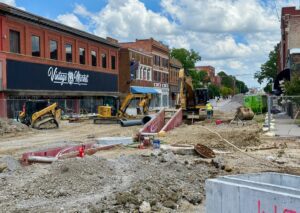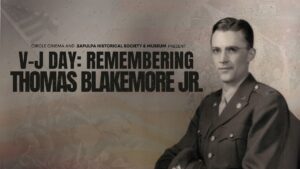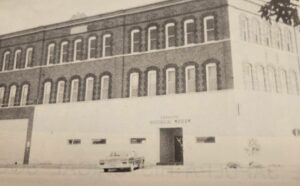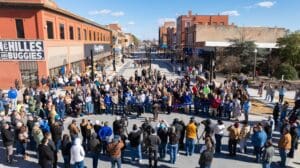Rachel Whitney, Curator,
Sapulpa Historical Museum
“The explosion was heard and felt all over Sapulpa.”
The city of Sapulpa was an oil boom town.
“Humans figured out how to increase the flow of fossil fuels from a well. It was simple: take an iron container about the size of a large thermos, stick some black powder or other explosives into it, stick a blasting cap on it, send it down the well, and then send a weight down to detonate it. BOOM. They called this, ‘Shooting the well!’ and believe the ‘!’ is required, as in ‘Yahoo!’”
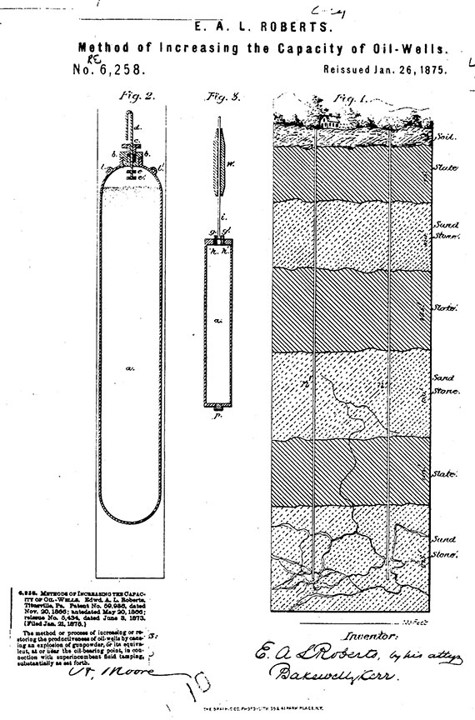
Oil Shooters, torpedos, and acid chemicals were a real thing and became a booming business for the oil companies. “Break things generally, indeed. The science doesn’t seem too complex. Break apart the rocks underground and it’s easier for the petroleum to flow through the seams.”
To treat the oil well, acidizing would become popular. For instance, in Glenpool, the fracking of the oil wells, usually with hydrochloric acid, many of the workers used glass jugs of acid to treat the oil well. The three-gallon to five-gallon glass jugs were used instead of metal containers because the acid would eat away at the material. The oil workers would take the glass jugs by the truckload, toss them down the oil well, and let the jugs break open, pouring the acid in the well.
“In the 1930s, its popularity waned as a result of the damage it could do to the steel linings of the wells. In subsequent years, however, corrosion inhibitor technologies were developed that effectively prevented this damage. This has led acidizing to once again be widely used in the oil and gas services industry.”
The Sapulpa Oil Shooters had a dangerous job. “In the oil patch days, they had to deal with nitroglycerin, a volatile, powerful explosive. Their function was to lower a torpedo (a long pipe or pipes) loaded with the chemical down into the hole of an oil well to the oil bearing strata and explode it.”
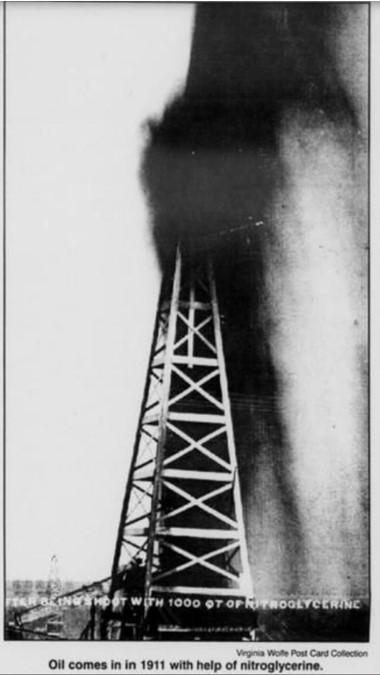
In 1930, the Sapulpa City Directories had many listings for oil companies, suppliers, and manufacturers. In the yellow pages, there was a section titled, “torpedoes.” There was one company listed, Bond Torpedo Company.
Oscar Bond moved to Sapulpa in 1910. He was listed as an oil shooter, then. In 1928 through 1932, he was listed as torpedo worker. He opened Bond Torpedo Company in 1928. He was the expert in the oil field fracking, explosives, and chemicals.
This week in Sapulpa history, on October 12, 1932, an accident happened just outside of town, just five miles west of the city. “Bond, a pioneer shooter, and one of the most experienced handlers of nitroglycerin in the state, had gone alone to the magazine this morning to load enough nitroglycerin to shoot a well for the Wiser Oil Company of Mounds. The well that was to have been shot this morning is located west of the Pickett Prairie Schoolhouse. Bond was driving a Chevrolet coupe with a small truck back, on which the explosive was loaded.”
An explosion shook the town and the surrounding area. “A nitro-glycerin explosion that rocked Sapulpa at 8:16 this morning, killed Oscar Bond, of the Bond Torpedo Company, at one of this nitro-gylcerin magazines near the boy scout camp, about five miles west of the city. The terrific explosion scattered bits of the magazine house, the nitro-glycerin containers, and the vehicle over an area of several hundred feet around the place.”
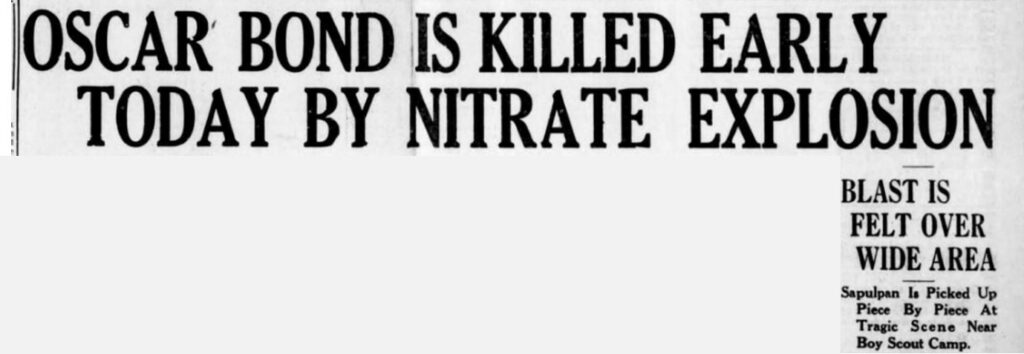
Tragically, the owner was near the vehicle when the explosive went off. “Searchers who congregated at the scene of the explosion within a few minutes, found numerous small pieces of the man’s body scattered over the hillside to the northeast of the magazine house. A scrap of a red plaid blazer which Bond wore this morning was found on the Country Club Golf Course several feet from the place where the explosion occurred.”
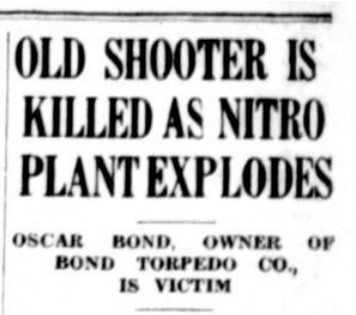
It was first reported that Bond was by himself, but one of his employees was on the company’s site, but was not near the vehicle that held the explosive.
“H.C. Showers, to whom the shot of nitroglycerin was to be delivered this morning for shooting a well, testified concerning the ordering of the explosive, and the failure of Bond to appear with it this morning. C.E. Kinley, of the Parisian Cleaners, identified the scrap of Bond’s blazer, as one that he wore. Pieces of the car were identified as the kind of car he drove. ”
The witnesses said that “the explosion sent up a cloud of dust and gas that could be seen for miles. It settled within a few minutes, however, and there was no fire. The main force of the explosion went to the northeast as the magazine house was situated on a hillside sloping from west to east.”
The report stated that since the explosion was so close to the golf course, “golfers on number 6 and number 7 holes would probably have been killed by the explosion.” At the golf course, “Curtis Redd was on his way to the golf course…Mrs. Berry, at the Country Club, was knocked to the floor by the force of the blast. The clock was torn from the wall, and windows were shattered.”
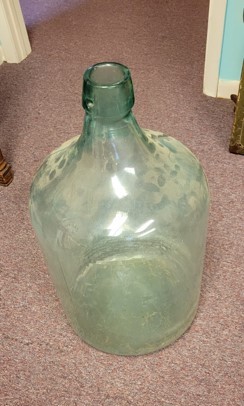
Many businesses in the city had damages to their building, as well. Glass windows of Redd’s Furniture Store, an empty building near Monning Store, the Harper Building, and the old bank building on the corner of Main and Hobson were broken. “A window at the Tourist Cafe on E Dewey was also broke. A window in the high school building was broken, and windows were shattered in several homes. The school bell at the Jefferson School was shaken down by the vibrations from the blast.
The explosion was large due to the “magazine house containing between 500 and 600 quarts of nitroglycerin at the time of the blast.”
The Lewis-Landrith Funeral Home was able to collect what they could for the deceased, his family, and the investigation.
“Oscar Bond had been a resident of Sapulpa for 22 years, and was known as one of the best shooters in the oil fields. He was born in Sweden, and came to America when he was six, settling in Pennsylvania. In June 1910, he came from Bradford, PA to Sapulpa to reside. He celebrated his fifty-second birthday in September. He was married 29 years ago in Kansas to Mrs. Gertrude Bond.”
(Sapulpa Herald, October 12, 15, 17, 1932, August 31, 1939; Democrat News, October 13, 1932; Sapulpa Daily Herald, November 29, 1997; Investopedia; PetroWiki; Earthworks; StateImpact: Texas Energy and Environment; The Atlantic)


